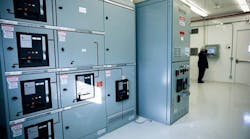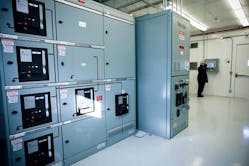Electrical safety has been a concern from the day the first cable was run into a building. After more than a century of energizing facilities, the electrical industry has developed strategies and products that create safe environments for people and property. Unfortunately, some of those strategies sacrifice reliability and can plunge a facility into darkness in the name of safety. Today's engineers and facility managers need to find ways to enhance uptime while providing a safe environment.
In the early days of electricity, engineers developed circuit protective devices with a simple mission: to isolate overloads and faults. The primary goal was protecting the distribution system from damage — saving the wire. Engineers wanted to protect from fire and the collateral damage it might cause. The driver of this strategy was simple: protection without consideration of uptime. So the system provided protection, but it had a negative impact on reliability. Without selectivity, the circuit protective device nearest the fault may not be the one to clear the fault, resulting in larger outages than needed.
As technology and understanding developed, engineers sought to create circuit protection that also increased reliability — protecting against faults and overloads in a more precise or targeted way.
By eliminating the fault at the protective device nearest the fault, engineers could provide protection with a minimal outage impact. Engineers first used overcurrent protection with staggered time-delays to reduce the downtime footprint of a trip. Downstream circuit protective devices would be set to protect the load, and upstream breakers would have staggered time delays to allow the downstream breakers to clear a fault. This strategy delivered reliable selective coordination.
This selective coordination strategy of nested time delays has a protection downside. Nested time delays work well in a "through fault" condition, which is when the fault is downstream and the circuit protective device closer to the fault operates to clear the fault. In this scenario, both the downstream and upstream circuit breakers detect the current as a fault. The time delay of the upstream circuit breaker is longer than the delay and clearing time of the downstream circuit breaker. Thus, the downstream circuit breaker has time to operate and clear the fault.
If the fault is between the upstream and downstream protective device, however, the upstream device responds at its nested time delay before operating. This results in slower protection and more potential for damage. This compromise between protection and selectivity has existed for years.
Getting in the zone
Nested time delays were not good enough to deliver the level of selectivity and protection systems need. The engineering community's next step toward selectivity and uptime was zone protection — protecting a defined zone in the power distribution system. Instead of focusing on a single upstream/downstream path, zone protection identifies and removes faults only within a defined zone. The two most common types of zone protection are zone selective interlocking (ZSI) and bus differential protection.
ZSI was first introduced to enhance selective coordination. In a ZSI scenario, a downstream circuit protective device communicates with an upstream device when a current above the fault threshold is detected. Once the upstream device receives the signal, it "restrains" and shifts to a longer time delay, allowing the downstream device to clear the fault. If the downstream device fails to clear the fault, the upstream device provides back-up protection and operates. This communication is usually a non-digital Boolean signal over dedicated twisted pair wiring between protective devices, such as low-voltage power circuit breaker trip units.
Bus differential protection is based on Kirchoff's Law. It takes a zone in the power distribution system and looks at all of the currents flowing into the zone and all the currents flowing out of the zone. If there is a difference between the two that exceeds the set pick-up level, the bus differential relay initiates a trip to all of the protective devices that feed that zone. This provides fast, selective protection for that zone.
While ZSI and bus differential have been available for years, they are not commonly implemented. The added expense of equipment and implementation costs often rule them out as options. For example, ZSI requires wiring from each downstream device to the associated upstream device and often includes specific hardware in this path. Bus differential protection requires a bus differential protective relay connected to dedicated current transformers (CTs) on every circuit in the protected zone. When bus differential is implemented, it is most commonly used in medium-voltage equipment or applications rather than low-voltage applications.
Enter arc flash and heightened concerns
The recognition of and sensitivity to arc flash is changing the perspective and use of zone protection. Increasing fault currents exacerbate the situation and increase arc flash dangers. In fact, it is not uncommon to see 100kA and above in many of the systems today.
The energy of an arc flash event is driven primarily by the current magnitude and the arc duration. The increase in fault currents coupled with the staggered (or nested) time delays for selectivity can result in hazard potential that may even make the equipment unapproachable.
Protection from arc flash may seem simple on paper: The goal is to maintain selectivity and add-back protection to clear faults without artificial time delays. With ZSI, the upstream breaker can be set to protect with no added time delays for coordination, enabling the ZSI signal to restrain the device. Faster protection means lower incident energy and potentially less risk to personnel and damage to equipment. Bus differential provides fast protection and only operates when there is a fault in the zone. This provides selectivity and protects against in-zone faults.
Arc flash mitigation has influenced the industry to re-evaluate engineering design practices and recommended best practices in this area. Section 240.87 of the 2011 edition of the NEC states that a circuit breaker without an instantaneous trip must be provided with one of the following: ZSI, differential protection or an energy-reducing maintenance switch with local indication. NFPA 70E Annex 0.2.3 has added zone protection references. ZSI and differential protection are now being more widely applied for 7x24 protection and maintaining selective coordination.
Expanded ZSI with network communications
Until recently, ZSI has been limited to a distance of approximately 1,000 feet of wire. A trend in the industry is using IEC-61850 network communications for expanded control, which can include ZSI protection. IEC-61850 covers multiple communication protocols, including GOOSE — Generic Object Oriented Substation Events — a high-speed peer-to-peer Ethernet-based communication protocol. GOOSE can communicate more than simple ON/OFF information during a fault, including data such as time delays. It is not limited to the non-digital Boolean signal used for traditional wired ZSI.
GOOSE's flexibility makes it a candidate for many systems solutions. It can be used across multiple divergent devices from different vendors. It also operates seamlessly with different types of relays, such as transformer differential and overcurrent.
By implementing GOOSE functionality, engineers can attain a new level of protection with uptime. The protocol has a high degree of connectivity and information exchange for implementing multiple protective and selective functions. Through GOOSE's peer-to-peer publish and subscriber capability, a device can publish to all or to specific types of devices in the system. Devices can also be designated as subscribers to specific types of devices or messages from specific devices. Messages can also be given priorities, addressing latency concerns.
What's next?
Since the invention of the first simple fuse, engineers have been striving to make electrical systems safer. It's a quest that will never end. But along with safety, engineers have also developed technologies that consider the practical needs of electricity users to have energy available whenever they need it. Safety and uptime are now more commonly available than ever in the history of the electrified world. New ideas on the horizon will surely increase both the reliability and safety of electrical systems for industrial and commercial applications.
Barber is an advanced electrical systems application engineer with GE's Industrial Solutions business.




